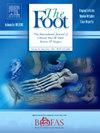Postoperative foot drop after gastrocsoleus lengthening in children with unilateral and bilateral cerebral palsy
Q2 Health Professions
引用次数: 0
Abstract
Background
Equinus foot is a frequent deformity in children with cerebral palsy (CP). After calf-muscle lengthening surgery, foot drop is frequent and seems to occur mainly in unilateral CP cases. It remains unclear if this complication can be prevented with same-procedure transfer or shortening of dorsiflexor tendons.
Methods
Retrospective analysis of 167 ambulant children with unilateral and bilateral CP, GMFCS levels I to III, who received surgical calf-muscle lengthening. Pre- and postoperative 3D instrumented gait analysis and clinical examination data were reviewed.
Results
Stance and swing phase dorsiflexion improved in both groups. Postoperative mean swing phase dorsiflexion was significantly lower in unilaterally affected than in bilaterally affected children (median −6° vs. +1°, P < .001). The incidence of postoperative foot drop in unilaterally and bilaterally affected patients was 50 % and 16 %, respectively, with a significant group difference (P < .001). Tendon transfers did not lead to a lower rate of postoperative foot drop, but were performed in children with more severe preoperative findings.
Conclusion
Children with unilateral CP are at a higher risk of postoperative foot drop after calf muscle lengthening than the bilaterally affected. Although the range of motion improved postoperatively, tendon transfers did not improve active dorsiflexion in children with unilateral CP and could thus not prevent foot drop effectively. Due to these findings, prospective research with preoperative assessment of tendon-muscle function is needed in this field.
单侧和双侧脑瘫患儿腓肠肌延长术后足下垂
背景:下肢足是脑瘫(CP)患儿常见的畸形。小腿肌肉延长手术后,足下垂是常见的,似乎主要发生在单侧CP病例。目前尚不清楚这种并发症是否可以通过相同的手术转移或缩短背屈肌腱来预防。方法回顾性分析167例单侧和双侧CP, GMFCS等级为1 ~ 3级的患儿行小腿肌延长术的临床资料。回顾了术前和术后三维仪器步态分析和临床检查数据。结果两组患者站姿和摆相背屈均有改善。单侧受累患儿术后平均摆动期背屈明显低于双侧受累患儿(中位数- 6°vs +1°,P <; .001)。单侧和双侧患者术后足下垂发生率分别为50 %和16 %,组间差异有统计学意义(P <; .001)。肌腱转移并没有降低术后足下垂的发生率,但在术前发现更严重的儿童中进行。结论单侧CP患儿小腿肌肉延长术后足下垂风险高于双侧CP患儿。虽然术后活动范围得到改善,但肌腱转移并不能改善单侧CP患儿的主动背屈,因此不能有效预防足下垂。由于这些发现,在这一领域需要前瞻性研究和术前评估肌腱肌肉功能。
本文章由计算机程序翻译,如有差异,请以英文原文为准。
求助全文
约1分钟内获得全文
求助全文
来源期刊

Foot
Health Professions-Podiatry
CiteScore
2.00
自引率
0.00%
发文量
37
期刊介绍:
The Foot is an international peer-reviewed journal covering all aspects of scientific approaches and medical and surgical treatment of the foot. The Foot aims to provide a multidisciplinary platform for all specialties involved in treating disorders of the foot. At present it is the only journal which provides this inter-disciplinary opportunity. Primary research papers cover a wide range of disorders of the foot and their treatment, including diabetes, vascular disease, neurological, dermatological and infectious conditions, sports injuries, biomechanics, bioengineering, orthoses and prostheses.
 求助内容:
求助内容: 应助结果提醒方式:
应助结果提醒方式:


